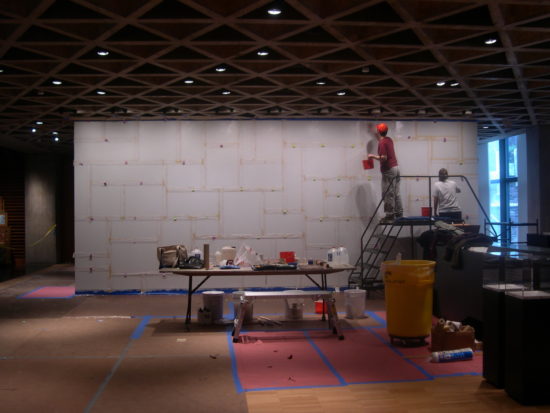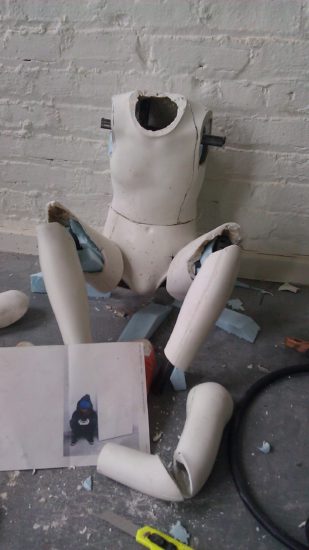Harriet Salmon is a practicing artist and arts professional. She’s worn many hats in the art world including fabricator, curator, small business owner, gallerist, Senior Photo Editor at Artforum Magazine and a consultant for arts-based nonprofits. She is currently the host and producer of the podcast Craftsmanship.
In 2006, I was a young MFA student lucky enough to witness the installation of Sol Lewitt’s Wall Drawing #614 in the lobby of the newly-renovated Yale University Art Gallery. A flurry of activity emanated from labored wall preparations, careful measuring, taping, and masking; every move dictated to a team of fabricators by the artist’s written instructions.
It was a wonder to watch. Seeing Lewitt’s team physically enact the artwork’s conceptual commentary on production, industrialization, and authorship was an incredible experience. I thought of it often over the next few years as I began working as a fabricator in the New York contemporary art world. In Lewitt’s work the relationship between artist, fabricator, concept, and artwork were so well-defined and purposeful, though in the coming years I found this was not always the case. The repercussions of these relationships were a common topic of conversation within the fabrication community.


I went to work at a fabrication company that specialized in mold making and quickly realized the breadth of the business within the New York art world. Made up of a blend of industrially trained craftspeople and young artists trying to earn a living wage, this community was producing a large percentage of the objects engaged in the global art economy, a market currently estimated to generate over $60 billion dollars in annual sales. Because of their vantage point within the art world, they were keenly aware of hierarchies within craft vs. concept, questions of intellectual property, trends of de-skilling in art, wealth disparity, and the conflict felt by many of them between working in art production and being artists in their own right.
These questions inspired me to begin collecting an oral history of fabricators, which I then developed into a podcast called Craftsmanship for public engagement in 2019. By interviewing this close-knit and often secretive community about 20 years of personal and professional experiences, I aim to document voices often overlooked by institutions, creating an important record of the skills and techniques that are being used to make contemporary art today. The interviews not only include production notes, they also discuss the conceptual, economic, and ethical ramification of fabrication in its current state.
Many scholars have tackled the subject of industrial fabrication, where artists hire professional workers that are skilled in industrial manufacturing techniques to produce artworks. Michelle Kuo’s October 2007 Artforum article entitled “Industrial Revolution: The History of Fabrication” and Art in the Making (Thames & Hudson, 2016) by Glenn Adamson and Julia Bryan-Wilson do an impressive job of examining technological advancement and manufacturing’s relationship to an artist’s practice. However, I’d add that the last 20 years have produced a form of post-industrial fabrication, where art production is falling more and more into the workshops of other, more skilled and often less financially successful artists rather than manufacturing-based laborers. These artist/fabricators tend to specialize their techniques based on developable skills or personal interest, anything from digital prototyping to project management, and are working to provide an array of highly sophisticated services to their artist clients.
These new relationships further blur the lines between artist, fabricator, concept, and artwork that Lewitt so carefully laid out in his wall drawings. When does the object become the art work? When it leaves the fabricator’s studio or when it arrives at the gallery? At what moment does it become worth its auction price? With the thousands of tiny decisions that go into crafting an object, how much of the fabricator’s tacit knowledge is present in the final piece? If the artist was unaware of them, are these tiny decisions important when conserving the object? Who gets or even wants public credit for the artwork? If a fabricator invents a technology, which artists get to use it in their practice? How comfortable are all parties involved with the idea of collaboration?
At this point we have mostly unanswered questions, although hopefully answers are beginning to surface from my conversations with the post-industrial fabrication community. For example, something as simple as what you tell your family you do or how you are introduced by the artists you work for can make a huge difference. I spoke with fabricator and assistant Matt Quinn about these topics right off the bat in the first episode of Craftsmanship:
Harriet Salmon: What do you tell family members you do when they don’t have any understanding of fabrication?
Matt Quinn: I explained to them that (it’s like) I’m in Elvis’s Band. Like if I were to describe it to one of my uncles or aunts at Thanksgiving I would say it’s more like being a studio musician… like being a multi instrumentalist. What I would say was, “Elvis comes in with a four chord song on an acoustic guitar and we’re sitting there with his album in front of us and I could say on this track I played rhythm guitar… on this track I did backing vocals, the last three songs I did the string arrangements and I also am a recording technician.”
And then their next question is invariably; “well, do you get credit?”
HS: And what do you say to that?
MQ: I say, “no, I go to a lot of parties!”
I think at least in my current situation, it’s one of the things I’m lucky for, is that I get introduced as a human being at those parties. I think that’s a pitfall of working as an assistant…
HS: …that some artists don’t introduce you?
MQ: Yes. That there’s an expectation that… I would remain in the shadow, as if it’s some kind of dirty secret. It’s something that a boss with less confidence maybe (would do). Whereas (in) my current situation I could say I’m actively grateful for the fact that I am introduced as an artist.
I hope that by collecting these oral histories, I can expand the public’s knowledge and give them a working understanding of how fabricators are currently participating in the contemporary art world. Currently I have interviews published with Matt Quinn, Ander Rydstedt (a glassblower for artists such as Josiah McElheny and Martha Freidman), Matthew Lange (the former assistant and now estate manager for Sarah Charlesworth), Matt Dilling (owner of Lite Brite Neon Studio) and Jason Brown (owner of Alchemy Paintworks, a high-end spray finish shop). My aim is that sharing these fabricator’s experiences, and their histories, will help create an important scholarly precedent going forward for conservators, art historians, and cultural institutions.
You can listen and subscribe to the Craftsmanship podcast on iTunes and at www.craftsmanshippodcast.com.

